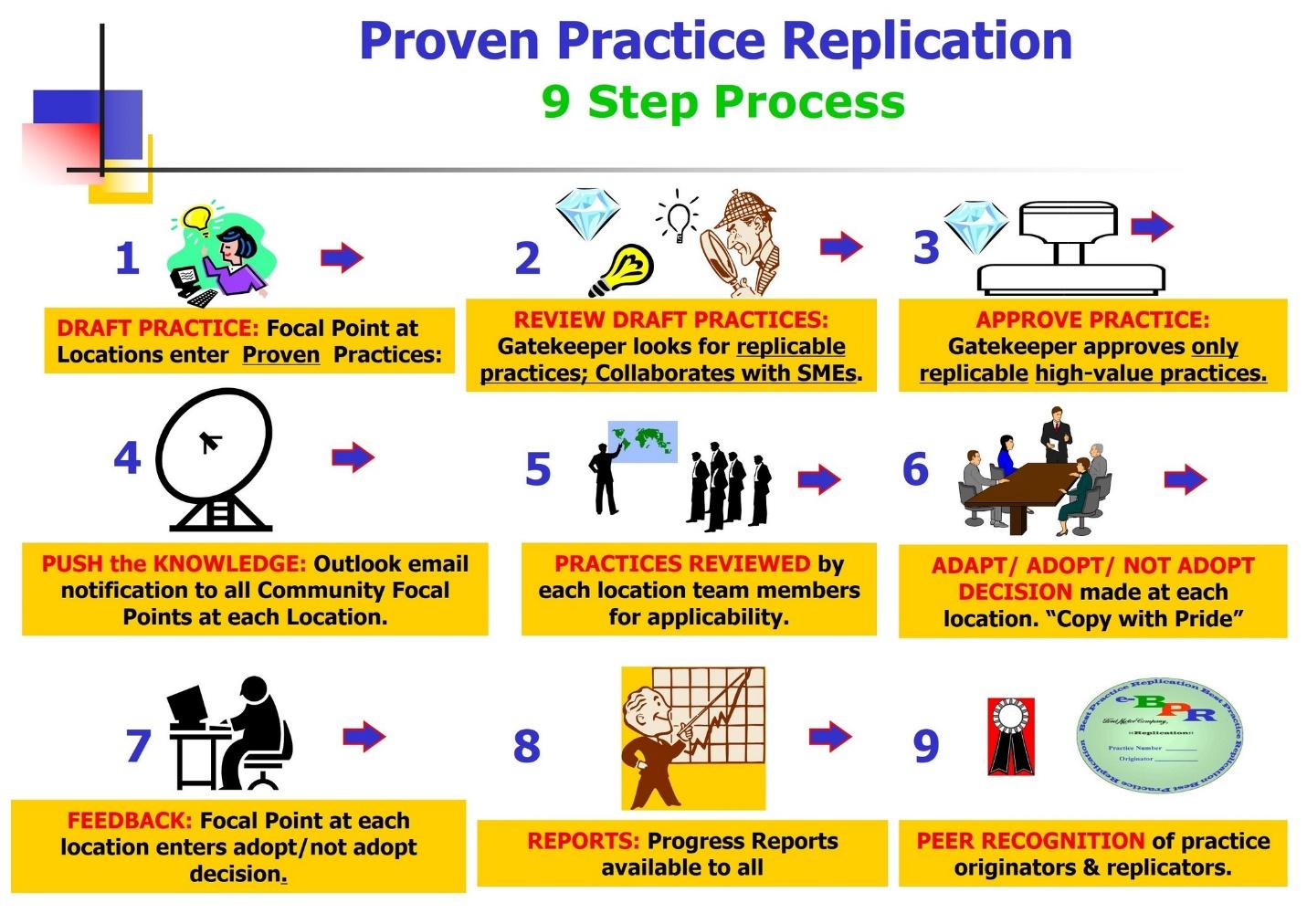KM Component 17 – Proven Practices Process

Stan Garfield
In knowledge management, a proven practices process involves selecting, documenting, and replicating procedures that have demonstrably improved business results. As a result, others in similar environments or with similar needs can benefit from proven successes.
Proven practices are methods that have been demonstrated to be effective and lend themselves to replication to other groups, organizations, and contexts. Typically referred to as “best practices,” they are sometimes called “good practices.” The problem with the term “best practice” is that it connotes that an ideal has been achieved, where “proven practice” more reasonably asserts that an approach has been tried successfully. It’s better to learn about and adapt proven practices that fit your environment, whether or not they are the “best.”
One of the key benefits of knowledge management is making the organization’s best problem-solving experiences reusable. Consistently applying proven practices can significantly improve the results of any firm. For example, if a manufacturing plant in one part of the world has figured out how to prevent the need for product rework, and all other plants around the world adopt this practice, savings will flow directly to the bottom line. By establishing a process for defining, communicating, and replicating proven practices, an enterprise takes advantage of what it learns about solving problems.
Communities of practice are a natural vehicle in which proven practices can be shared. Threaded discussions, repositories, and community knowledge sharing events can be used to publicize proven practices and encourage their application. Document templates for proven practices should be provided so that all necessary content is captured, including process descriptions, photos, and specifications. Video recordings can be helpful in showing how a process is actually performed, and can be delivered through standard e-learning systems.
Proven practices should be as specific as possible, have obvious benefits, and be readily reproducible. Consider offering a formal process for collecting, storing, disseminating, and replicating proven practices. The resultant benefits can often be used as proof of the value of a KM initiative.
10 Ways to Replicate Proven Practices
- Nurture a knowledge sharing culture in which proven practices are replicated.
- Set an objective to increase profits by sharing and reusing proven practices, or to lower sales and delivery costs by replicating proven practices.
- Implement proven practice strategies:
- Motivate: provide incentives for sharing and reusing proven practices.
- Analyze: select proven practices from collected stories.
- Disseminate: distribute proven practices in a monthly newsletter.
- Demand: allow searching the proven practice repository.
- Act: reuse proven practices on new opportunities.
- Set goals for proven practices, for example:
- Have community members share proven practices in discussions and on calls.
- Harvest collected knowledge in the form of proven practices.
- Implement changes to existing processes to enable replication of proven practices.
- Identify and designate proven practices.
- Document and replicate proven practices.
- Measure performance against goals. For example, report the number of proven practice documents downloaded, and the reported value of replicated proven practices as collected in user surveys.
- Capture proven practices as pictures, video, and audio telling the story of how to apply them. This will make them easier to replicate than if they are in a written document. If you get teams to discuss proven practices on podcasts, the knowledge will be more effectively shared than if the same information was written down and submitted to a database. Hold a regular conference call where presenters demonstrate their proven practices and explain how to replicate them.
- Review collected information to reveal patterns, trends, or tendencies which can be exploited, expanded, or corrected. After collected knowledge has been analyzed, it can be codified to produce repeatable processes by identifying proven practices.
- Send out email messages sharing proven practices to increase awareness.
- Provide incentives for proven practices, for example, the people who submit the proven practices that are the five most replicated will each win a financial reward.
- Participate in the International Best Practice Competition.
Methods
Here are five KM methodologies for proven practices.
- Appreciative Inquiry is the co-evolutionary search for the best in people, their organizations, and the relevant world around them. In its broadest focus, it involves systematic discovery of what gives life to a living system when it is most alive, most effective, and most constructively capable in economic, ecological, and human terms. This process can be applied in almost any context, and the philosophy can be applied to proven practices.
- Positive Deviance is based on the observation that in every community there are certain individuals or groups whose uncommon behaviors and strategies enable them to find better solutions to problems than their peers, while having access to the same resources and facing similar or worse challenges. It is an asset-based, problem-solving, and community-driven approach that enables the community to discover these successful behaviors and strategies and develop a plan of action to promote their adoption by all concerned.
- Checklist is a job aid used to reduce failure by compensating for potential limits of human memory and attention. It helps to ensure consistency and completeness in carrying out a task.
- Most Significant Change is the collection of significant change stories emanating from the field level, and the systematic selection of the most significant of these stories by panels of designated stakeholders or staff. Once changes have been captured, people sit down together, read the stories aloud, and have in-depth discussions about the value of these reported changes.
- Proven Practice Replication is a process developed at Ford for ensuring that proven practices are shared and replicated across multiple manufacturing plants. A community of practice (e.g., body assembly) focal point person looks for noteworthy practices, prepares a picture sheet using a web template, quantifies the benefits, and emails it to a company-wide community administrator. The administrator screens all submissions, and if they are gems, they are posted on the intranet and emailed to all community focal points. The community focal points then take them to plant management, who must report if they will adopt, adapt, investigate, or reject, and the reasons for their decision. Adoption scores are kept by community and by plant.


Stan Garfield
Please enjoy Stan’s additional blog posts offering advice and insights drawn from many years as a KM practitioner. You may also want to download a copy of his book, Proven Practices for Implementing a Knowledge Management Program, from Lucidea Press. And learn about Lucidea’s Inmagic Presto and SydneyEnterprise with KM capabilities to support successful knowledge curation and sharing.
Similar Posts
Only You Can Prevent Knowledge Loss: How to Practice “Knowledge Archaeology”
An overview of ways in which knowledge is lost, with examples of how to perform knowledge archaeology to recover and restore it.
Ready to Read: Profiles in Knowledge: 120 Thought Leaders in Knowledge Management
We are pleased to announce that Stan Garfield’s new book, Profiles in Knowledge: 120 Thought Leaders in Knowledge Management, is now available from Lucidea Press.
Lucidea’s Lens: Knowledge Management Thought Leaders Part 92 – Jay Liebowitz
Jay Liebowitz is a professor, consultant, author, and editor. His research interests include knowledge management, data analytics, intelligent systems, intuition-based decision making, IT management, expert systems, and artificial intelligence.
Lucidea’s Lens: Knowledge Management Thought Leaders Part 91 – Frank Leistner
The late Frank Leistner was the former Chief Knowledge Officer for SAS Global Professional Services, where he founded the knowledge management program and led a wide range of knowledge management initiatives up until 2012.




Leave a Comment
Comments are reviewed and must adhere to our comments policy.
0 Comments